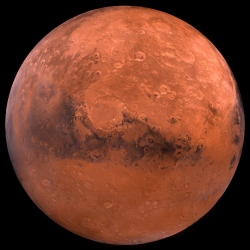
There are a lot of things about Mars that mankind has yet to uncover. During a recent mineral mapping project, NASA said they have discovered mineral deposits underneath the ice sheets suggesting that volcanoes erupted under the ice.
In a recent press release by NASA’s Jet Propulsion Laboratory, it is stated that volcanic eruption beneath the ice sheets on the red planet might have happened billions of years ago based from the findings by the Mars Reconnaissance Orbiter.
According to NASA, this new findings will help researchers understand the history of volcanic eruptions on Mars. Scientists used the mineral-mapping spectrometer to study the surface of Mars where a different topography is clearly visible, they zeroed in on an area called "Sisyphi Montes."
Sheridan Ackiss of Purdue University said "Rocks tell stories. Studying the rocks can show how the volcano formed or how it was changed over time…I wanted to learn what story the rocks on these volcanoes were telling."
Cosmos Magazine said that the evidence suggesting that there were volcanic activities underneath the surface of Mars can give light to the ongoing debate on whether organisms lived on Mars before, they said it "could have set the stage for microbial life to thrive". There’s a specific technology design for the purpose of finding whether or not any form of life existed on Mars, which is the Compact Reconnaissance Imaging Spectrometer for Mars (CRISM). It is tasked to "find rock records of past environments that could have supported primitive life, and to search for evidence of whether or not life formed."
Although CRISM is yet to find signs of life, NASA said they were able to arrive at new and great findings because of it. . "We wouldn’t have been able to do this without the high resolution of CRISM."
NASA said their latest research found new minerals underneath the ice sheets on Mars. "Characteristic minerals resulting from such subglacial volcanism on Earth include zeolites, sulfates and clays. Those are just what the new research has detected at some flat-topped mountains in the Sisyphi Montes region examined with the spacecraft’s Compact Reconnaissance Imaging Spectrometer for Mars (CRISM), providing resolution of about 60 feet (18 meters) per pixel."
Currently, NASA has two active orbiters and two rovers exploring the red planet, in preparation of the anticipated Journey to Mars.
